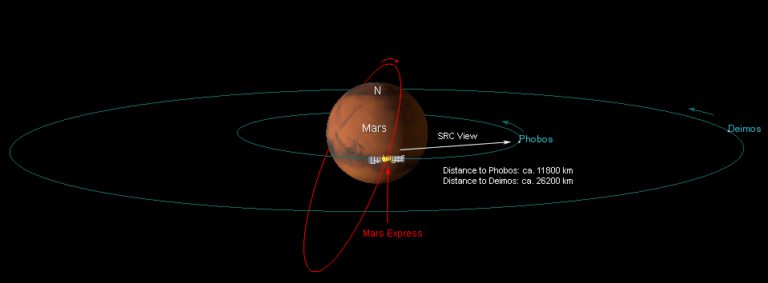Emily Lakdawalla • Dec 11, 2009
Awesome Mars Express view of Phobos and Deimos together
My inbox was exploding this morning with messages about a tremendously cool animation released this morning by ESA's Mars Express team. It shows Phobos and Deimos together, with Phobos crossing Deimos, in what's known as a "mutual event." It's the first animation of its kind ever produced by a Mars orbiter -- and there have been a lot of Mars orbiters!

Cassini has been capturing mutual event movies like these of Saturn's moons for years; here's just one example grabbed at random from our image library.

If Cassini can get so many of these mutual event animations, why is the Mars Express one the first from Mars? The answer has to do with the geometry of the orbits. Mars' moons, like most of Saturn's moons, travel around the planet in paths aligned pretty much exactly with Mars' equator. But if Mars orbiters traveled in equatorial orbits, the only parts of Mars they'd see at high resolution would also be along the equator. To map Mars, orbiters travel in nearly polar orbits; as Mars rotates underneath them, they eventually get to see all of Mars' surface up close. But that geometry makes a conjunction of Phobos and Deimos in one camera frame an extremely rare event. The two moons have to be perfectly aligned at the moment that the orbiter crosses Mars' equator for such images to be possible.

Cassini sees these events much more often because, at certain times during its mission (including now!), Cassini has traveled in an orbit that's in Saturn's equatorial plane, collapsing the orbits of the moons into back-and-forth paths along one arc in Cassini's "sky" and massively increasing the opportunities Cassini has had to witness mutual events. Unlike Mars orbiters, Cassini can use gravity assist flybys of a massive moon -- Titan -- to tip the inclination of its orbit, getting polar perspectives at some times and equatorial perspectives at others.
One thing you may notice about the animation is a certain fuzziness to the outlines of the moons. That arises from some problems with the optics within the Super Resolution Channel (SRC) of the Mars Express High Resolution Stereo Camera (HRSC). HRSC has two components. The main instrument is a pushbroom-style camera (similar in style to MOC on Mars Global Surveyor and HiRISE on Mars Reconnaissance Orbiter) that produces long, narrow image swaths with many colors and many millions of pixels each, with stereo coverage allowing the construction of digital elevation models. In addition, HRSC has a framing camera called the Super-Resolution channel (SRC) that grabs little snapshots, single one-megapixel, black-and-white frames, at much higher angular resolution, here and there along the much bigger image swaths. But SRC was found after launch to suffer from astigmatism (as well as a host of other problems that reduce its effectiveness). Over time, the HRSC team has developed processes that reduce the amount of blur in SRC images, but there's only so much they can do. They had to use the SRC for this sequence. Animations like this one can only be produced by a framing camera; with a pushbroom camera, time shifts along the axis of the image, and instead of getting multiple frames of this cool mutual event, you'd only get a single image with at least one of the two moons smeared out as it moved while HRSC was taking the image.
Although the Mars Express animation is the first high-resolution view of a Phobos and Deimos mutual event, it is not, in fact, the first animation containing both Phobos and Deimos to be sent back from Mars. Spirit accomplished that first, back in August of 2005. At the time, it was Spirit's second summer on Mars and the rover was high in the Columbia Hills with power to burn; the rover team used up extra power by performing lots of nighttime observations. Here's one six-frame animation captured not long after local midnight, in the wee hours of sol 590. The moons are not just dots in the sky; Spirit's sharp-eyed Panoramic Camera resolves both as disks. You can even see some of the shape of Phobos from its shading! (Careful, though; in the first few frames, the detector saturated on Phobos and charge from those saturated pixels "bled" into adjacent pixels, spreading out the disk a bit.)

You can also see how Phobos' and Deimos' motions across the Martian sky differ. Deimos, like our own moon, orbits Mars at an angular rate slower than the planet's spin, so it rises in the east and sets in the west, just like the Sun, and moves relatively slowly in the sky (since its orbital motion is partially canceled by the rotation of the planet). But Phobos orbits Mars so closely that it travels faster than the planet spins, making it rise in the west and set in the east about twice a day as seen from the ground. Spirit's camera stood still as this animation was being captured; the star field was also drifting through the field of view, with the same sense of motion as Deimos, only faster. (A stacked version of this image sequence is available here, in which you can see how the background star field (including the bright star Aldebaran) was moving. I chose not to stretch the contrast in the images so you could see Aldebaran, because in doing so I would have saturated Phobos, making it harder for you to see how Spirit resolved its shape.) (Thanks to Dan for the tip to that image sequence.)
As neat as the Spirit animation is, it has nothing on today's from Mars Express. Mars Express is uniquely capable of studying Phobos, for reasons I explained at length in this post. Looks like it may be time soon for me to check back into the Mars Express data archive for more cool views of Phobos and Deimos!
Let’s Go Beyond The Horizon
Every success in space exploration is the result of the community of space enthusiasts, like you, who believe it is important. You can help usher in the next great era of space exploration with your gift today.
Donate Today

 Explore Worlds
Explore Worlds Find Life
Find Life Defend Earth
Defend Earth

